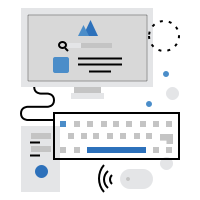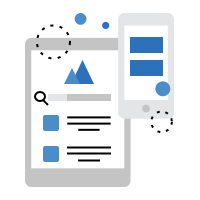This page (and all tabs) has been moved to https://support.goalexandria.com/knowledge-base/kiosk-mode/
Overview
A kiosk is a computer, tablet, or smartphone with settings that limit user access to certain apps and webpages. Usually, browser windows are full screen and the address, tools, menu, and status bars are hidden. For this reason, you may want to set up kiosks for patrons to use Researcher, Self-Service, and Activity. That way, they can search, sign in, check out, and more without being able to do anything else on that device.
Alexandria is web-based, so you can access any module from any computer. On mobile, you can access all areas of Researcher (except Search and Bulletins), Self-Service, Activity, and Offline Mode. All you need is the URL!
Learn how to set up kiosks on your device's specific operating system and internet browser.
Computer Kiosks
You can set up a desktop or laptop computer as a kiosk. Simply follow the directions for your operating system and browser.
macOS
Configure your browser to run at startup
Login Items
Add your browser to your Login Items so it will automatically open when you start the computer. This will work for OS X Lion (10.7) through macOS Catalina.
- Go to System Preferences > Users and Groups (or Accounts in some older versions).
- Click on the user for which you want your browser to run at startup.
- Select the Login Items tab.
- Click on the + (plus) icon.
- Select your browser and click Add.
Shell Scripts
Alternatively, you can set up a shell script that will automatically open Chrome in full-screen to a designated website.
- Go to Finder > Applications > Automator.
- Select Application and click Choose.
- Double click on Run Shell Script.
- Copy and paste the following text into the text box:
/Applications/Google\ Chrome.app/Contents/MacOS/Google\ Chrome --app="https://ccdemo.goalexandria.com/librarian?" --kiosk --kiosk-printing --start-fullscreen - Replace
https://ccdemo.goalexandria.com/librarian?with the link to the website you want Chrome to automatically open. - Click File > Save. Name the script and make sure the file format is Application before clicking Save.
- Follow the Login Items instructions above to add this script to your startup items.
You may need to completely quit out of Chrome before testing or running this script for it to work properly.
Set up kiosk mode
For those on macOS Catalina, you can use the
app to set limits on apps and websites.Windows
Configure your browser to run at startup
The following steps will work with Windows Server 2008, Windows 7, and Windows 10.
To make a web browser launch automatically during startup, create a shortcut to the browser and place it in the Windows Startup folder:
- Click Start followed by (Windows System) Run and type:
- %userprofile%\Start Menu\Programs\Startup
- Please note that this location will only affect your user profile at startup; if you would rather have the browser launch at startup for every user who logs on to the computer, place the browser shortcut in this location instead:
- %allusersprofile%\Start Menu\Programs\Startup
- This opens the Startup folder for the current (or every) user profile.
- Now you’ll want to add a shortcut to the browser you want to open at startup in the folder.
- Right-click inside folder and choose New followed by Shortcut and provide the path to the browser for which you want to execute at startup.
- Drag the browser shortcut to the folder from your desktop or start menu.
- Copy and paste the browser shortcut from a different location.
- See set up kiosk mode to find out how to set up a special shortcut that opens the browser in full-screen kiosk mode.
Set up kiosk mode
Chrome OS (Chromebooks)
Configure your browser to run at startup
You can
on Chromebooks.Set up kiosk mode
Chromebooks now use
to manage app and website access for specified Google accounts.Mobile Kiosks
Set up a kiosk with a smartphone or tablet. Simply follow the directions for the type of device you have.
iOS (iPhone, iPad, iPod touch)
Save a webpage as an app
Save your Researcher Hub, Activity, and Self-Service links as apps on your device. Then you just have to simply click on the app to open that webpage in Safari!
- In Safari, go to the webpage you want to save as an app.
- Tap on the square and arrow icon at the bottom of the screen.
- Tap Add to Home Screen and customize the name.
- Tap Add when you're done.
Safari is currently the only internet browser in iOS that can save webpages as apps.
Restrict access on devices
You can use Guided Access in Accessibility Settings to limit your Apple devices to one app and control which features are available.
Android
Save a webpage as an app
Save your Researcher Hub, Activity, and Self-Service links as apps on your device. Then you just have to simply click on the app to open that webpage!
Restrict access on devices
You can either
or use to limit your Android devices to one app and control which features are available.Researcher Preferences
There are several adjustments you may need to make to your Researcher preferences and settings if you're using kiosks.
Open in same tab
If your browser is locked to a single window or tab, you'll want to make sure your Explore buttons open in the same tab. To do this, go to Tools > Explore Builder and make sure Open in New Tab or Browser Window is unchecked for each button in every Explore pane you're using.
There's currently no way to get back to your main Researcher page from Bulletins, and going to Status from Search will open a new tab.
Inactivity timeout
Set Researcher to refresh every five minutes of inactivity by going to Preferences > Researcher > Researcher and changing the Timeout dropdown at the bottom to 5 Minutes. This way, if a patron doesn't clear their screen or log out before leaving the kiosk, Researcher will do it automatically.





